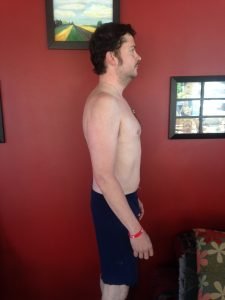I’ve always been conscious of how I carry myself. There’s something about seeing someone stand tall — not rigid, just naturally upright — that gives off confidence, energy, and presence. Good posture doesn’t just look better; it feels better. And when you lose it, you feel it everywhere — in your neck, your back, even your mood.
You start to notice it more as you get older — people walking hunched over, heads down, like gravity has been slowly winning for decades. It doesn’t happen all at once. It creeps in while we’re scrolling, slouching, and sitting too long. One day, you realize you’re not just tired — your whole body feels compressed.
That’s why I decided to do something about it. Not some extreme gym routine or posture brace — just 22 days of simple, focused steps. No overthinking. No fancy equipment. Just real, intentional actions to help reset your body and stand tall again.
What Causes Bad Posture in the First Place?
Bad posture isn’t just about slouching or laziness. It’s usually a mix of tight, shortened muscles and weaker stabilizing muscles that can’t hold your body upright for long. For a lot of us, that imbalance builds up slowly — the way we sit, the way we hold stress, even how we use our phones.
In my case, it’s both nature and nurture. I’ve always had a bit of a forward head tilt, and years of desk work and parenting didn’t help. Add in the habit of looking down at screens, and it became second nature to round my shoulders without even realizing it.
And it’s not just physical. Posture can reflect how we feel. Feeling defeated? You’ll likely slump. Focused or proud? You’ll stand taller without thinking. That’s why fixing posture isn’t just about stretching your body — it’s about re-training your habits, your awareness, and even your mindset.
Day 1: Your “Before” Picture — Start Where You Are
- Action: Take full-body photos (front and side) in your natural, relaxed stance.
- Reflection: How do those photos make you feel? Identify the areas for the biggest improvement.
This part might feel awkward, but it’s important: have someone take a full-body photo of you from the front and side, standing how you normally stand — not posed, not corrected. Just… you. Don’t suck in your stomach or pull your shoulders back. The point is to see your natural posture, as it is right now.
When I did this, I was surprised. Even though I thought I was standing up straight, the photos told a different story — head jutted forward, one shoulder slightly lower, and my abs basically hiding. I almost wanted to redo the picture and “fix it” — but that would’ve defeated the whole point.
This step isn’t about judging yourself. It’s about awareness. You can’t fix what you don’t see. Take the pictures, look at them, and just take note of where you are starting. It’s uncomfortable — I won’t lie — but that discomfort is exactly what sparks the motivation to change.
 |  |  |
 |  |
Days 2–4: Foundational Daily Stretches That Reset Your Posture
Before we start building strength, we need to undo some of the tightness that’s pulling your posture out of alignment. These next few days focus on stretching your chest, opening your shoulders, and bringing awareness to how your body should feel when it’s aligned.
Here’s the routine:
- Interlocked Finger Stretch: Clasp your hands behind your back, straighten your arms, and lift them as high as you can. Keep your chest open. Hold for 1 minute.
- “Arrest Me” Stretch: Hands behind your head like you’re getting cuffed, elbows pushed back, chest up. It’ll feel tight — that’s the point. Hold for 1 minute.
- Cobra Stretch: Lie on your stomach, palms flat beside your chest. Push your upper body up and look toward the sky. Hold for 3 seconds, repeat 20 times.
- Crow Lift: Arms stretched out to your sides, lie face down and lift your chest like you’re flying. 10 reps, 3-second hold each.
- Wall Alignment Check (Days 2 and 4): Stand with your back, shoulders, and head touching the wall. Close your eyes and soak in what “aligned” feels like. This is your reset posture.
What surprised me the most was how tight everything felt at first — especially my chest and shoulders. I didn’t realize how much tension I’d been carrying. But after just a couple of days, the stretches started to feel good. Like I was reclaiming space I’d been collapsing in on.
If you only do one thing from this challenge, do this routine. It’s that effective.





Days 4–7: Mental Shifts That Actually Work
Good posture isn’t just about moving differently — it’s about thinking differently. These next few days are about rewiring the small, subconscious habits that keep pulling you out of alignment.
Day 4: The “Above the Horizon” Trick
When you walk, where’s your gaze? Most of us look slightly down — especially when we’re tired or lost in thought. Today, walk like you’re scanning a crowd for someone. Don’t just lift your eyes — lift your whole head. Keep your chin level and your eyes just above where you’d normally look. It instantly shifts your posture and your mood.
Day 5: The Driving Fix That Changes Everything
Next time you get in the car, adjust your seat so you’re sitting tall — like you’re at a dinner table, not slouching into a couch. Then, set your mirrors while sitting with good posture. Now, if you slump, you won’t be able to see properly. It’s a passive posture check that works every single time you drive.
Day 6: Balance Brings Awareness
Stand on one foot for 30 seconds, then switch. Try it with your eyes closed for a challenge. It sounds simple, but balancing makes you tune into your core, your alignment, your breathing. And when you’re off, your body lets you know fast.
Day 7: Tech Neck, Meet Your Match
Hold your phone at eye level today. Every time. You’ll feel ridiculous at first, but lowering your neck to look down is one of the fastest ways to undo your progress. One small change, big impact.
These mindset shifts sneak into your day. That’s what makes them so powerful. You’re not just setting aside posture time — you’re building posture awareness into your normal life.
Days 6–9: Activate Your Core and Build Real Balance
Once your body starts opening up from the stretches, it’s time to engage the muscles that hold you upright. We’re not talking about crunches or gym routines — just simple moves that wake up the parts of your body that have been napping while you slouch.
Balance on One Foot
Stand tall, spine straight, and lift one foot off the ground. Hold for 30 seconds, then switch. Keep your gaze steady on a point ahead. This isn’t just a balance drill — it forces your core, hips, and ankles to fire together. Want a challenge? Try it with your eyes closed. Repeat three rounds per side.
Wall Angels
Find a flat wall and stand with your back against it — heels a few inches out, but your head, shoulders, and butt touching. Now, raise your arms slowly like you’re making a snow angel on the wall. Try to keep your arms and back in contact with the wall the whole time. Ten slow, focused reps. You’ll feel muscles you forgot existed.
Hourly Shoulder Rolls
Every hour, roll your shoulders — up, back, and down — five times. Not forward. Back and down. This resets your alignment and melts tension before it hardens into habit.
You might feel soreness in weird places — like between your shoulder blades or deep in your core — and that’s a good sign. These muscles are finally doing their job.
Day 10: The 10-Day Check-In — What’s Changing?
You’ve made it to the halfway mark — time to check in with yourself, both physically and mentally. Pull out the photos from Day 1 and take new ones in the same stance, same clothes if you can. Stand naturally again — no fixing, no posing.
Now, compare.
Notice anything different? Maybe your head isn’t jutting forward as much. Maybe your shoulders are a bit more even. Even subtle changes matter. They’re proof that your awareness is working — and that your muscles are starting to reset.
But this check-in isn’t just about what you see. Ask yourself:
- Are you thinking about posture more during the day?
- Do you catch yourself correcting when you slouch?
- Are any stretches starting to feel easier?
This is also a good time to tweak the plan. If a certain stretch feels amazing — keep it going. If something feels off or painful (not just sore), scale it back or modify. This challenge isn’t about pushing through pain. It’s about realignment, one conscious step at a time.
Days 11–22: Reinforce and Refine
Now that you’ve built the habit and felt the shift, the next phase is about reinforcing what works and adding just enough variety to keep your body — and mind — engaged.
Keep Your Core Routine
Stick with the stretches and movements that feel the most effective for your body. For most people, that means daily back and chest stretches, occasional wall resets, and mindset reminders like “above the horizon” or “shoulder blades in back pockets.”
Add a Twist (Literally)
To level up:
- Do your balance work on a pillow or yoga block to test stability
- Try yoga poses like Warrior II, Bridge, or Cat-Cow that promote spinal awareness
- Use a mirror occasionally — not to judge, but to visually reinforce proper alignment
Daily Awareness = Real Change
By now, posture has probably gone from something you never noticed to something you think about several times a day. That’s the real win. This kind of awareness rewires everything — how you sit, walk, even how you breathe.
Also, listen to your body. Some soreness is normal. Sharp pain? Back off. No challenge is worth pushing through real discomfort. You’re not here to “win” posture — you’re here to live in your body better.
After the Challenge: Keep It Going
You don’t need to start from scratch again — but you do need to keep showing up. Posture isn’t something you “fix” and forget. It’s a daily relationship with your body — one you’ve now started to rebuild.
What changed for me most wasn’t just how I stood — it was how I carried myself. I noticed I looked more alert, more confident. I felt taller. People commented on it. But more importantly, I noticed it when I didn’t — those slouchy moments didn’t feel normal anymore. They felt off.
You’ve built new muscle memory, rewired a few habits, and maybe even discovered that fixing your posture isn’t as complicated as you thought — it just takes consistent attention.
Your Quick Recap:
- Stretch daily, especially chest and shoulders
- Do wall resets when you need to realign
- Strengthen postural muscles with balance and wall angels
- Stay mentally aware: “above the horizon,” mirrors set for tall driving, tech at eye level
- Listen to your body — not all soreness is progress
This isn’t the end — it’s your new baseline. Keep walking tall.
Resources That Helped Me:
- Loving Fit website: https://www.lovingfit.com/
- Treat Yourself Therapy: https://www.painscale.com/article/do-it-yourself-back-therapy
FAQ: Fixing Bad Posture
Can you really fix posture in 22 days?
You can make noticeable improvements, yes — especially in awareness, flexibility, and core activation. Deep structural changes take longer, but 22 days is enough to break bad habits and build a solid foundation.
Is it too late to fix posture if I’m older?
No. While it might take more time and consistency, people in their 40s, 50s, and beyond have improved posture with the right stretches, strength work, and daily awareness. It’s never too late to stand taller.
Do I need equipment for this?
Nope. Everything in this plan can be done with just your body and a wall. A yoga mat, mirror, or pillow can help, but nothing is required.
What if I feel sore or stiff during the challenge?
Soreness is normal, especially if you’re activating muscles that have been asleep for a while. Sharp pain or pinching is not. Always adjust or skip anything that doesn’t feel right — and consider checking in with a professional if discomfort persists.
Will this fix my rounded shoulders or forward head posture?
It can significantly improve them, especially if those issues are caused by muscular imbalance or habit. If your posture problems are structural (like scoliosis), this plan can still help — but results will vary.
Posture isn’t just about how you look — it’s how you show up in the world. When you walk into a room standing tall, people notice. But more importantly, you feel different. More grounded. More present. More in control of your body.
If you’ve made it through this challenge — or even just a few days of it — that’s something to be proud of. Keep going. Make these habits part of your everyday life, and they’ll pay off in more ways than you can see in a photo.
And if you’re still on Day 1? That’s okay too. The hardest part is starting.
Let me know how it’s going for you in the comments — or better yet, post your own before and after. Not for perfection. For progress.
Walk tall, and welcome to the one percent.




Maintain the remarkable job !! Lovin’ it!
I only see 5 days in this 30-day challenge. I’m not seeing a button that takes me to other days. How do I find the rest of the 30 days?